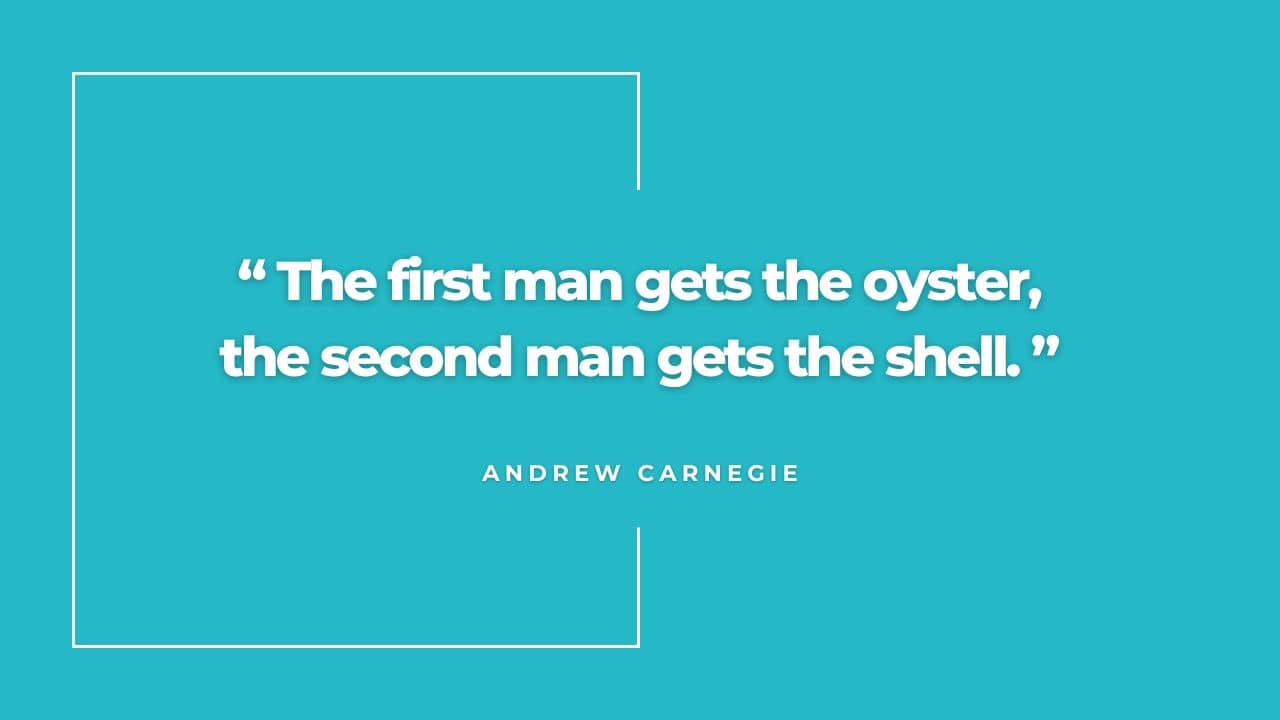Imagine being the first to discover a hidden gem—a pristine beach before it appears in travel guides or a viral product before it hits mainstream markets. The early bird not only gets the worm but often enjoys it without competition. This principle of being first, as Andrew Carnegie famously captured, “The first man gets the oyster, the second man gets the shell,” underscores a potent truth in both life and business.
gets the shell,” underscores a potent truth in both life and business.
Andrew Carnegie, a titan of industry, was no stranger to the benefits of being a trailblazer. His quote vividly illustrates the competitive edge gained by those who act swiftly and decisively. In the bustling realm of affiliate marketing, this concept resonates with even greater intensity. Here, the first to leverage new platforms, adapt to market changes, or endorse emerging products often reap outsized rewards.
This article explores how Carnegie’s principle of seizing the initiative translates into a tangible strategy in affiliate marketing. By embracing the role of a first mover, affiliate marketers can secure the best opportunities, leaving competitors to settle for the remnants.
Understanding the Quote
Explanation of the Quote
Andrew Carnegie’s maxim, “The first man gets the oyster, the second man gets the shell,” serves as a metaphor highlighting the immense value of being first in line. In a business context, this statement emphasises the advantages of pioneering—securing the primary rewards from an untouched market or opportunity before others have a chance to claim a share. This is particularly relevant in industries where innovation and timeliness are crucial to success. The ‘oyster,’ in this case, represents the rich rewards of early initiative, such as market dominance and high profit margins, while the ‘shell’ suggests the lesser value left for those who follow.
Historical Context
Andrew Carnegie, born in 1835 in Scotland and later emigrated to the United States, rose from humble beginnings to become one of the most successful industrialists of his time. His ventures in steel manufacturing helped catalyse America’s industrial revolution, making him a pivotal figure in the shaping of modern industry. Carnegie was a quintessential first mover; his strategic investments in steel and railroads at a time when America was undergoing massive expansion allowed him to capitalise on opportunities that others couldn’t see or were too hesitant to seize.
Carnegie’s success was not just in choosing the right industries but also in his innovative approaches to business. He implemented technologies and processes, like the Bessemer process for steel manufacturing, which drastically increased production efficiency and output before his competitors. This adoption of cutting-edge technology and methodology exemplifies the essence of his quote—while others were still pondering the changes, Carnegie was already reaping the benefits from his foresight and quick actions.
The First Mover Advantage in Affiliate Marketing
Defining First Mover Advantage
In the context of affiliate marketing, the first mover advantage refers to the benefits an affiliate gains by being the earliest to market or promote a product, service, or niche before it becomes widely recognised or saturated. This strategy involves identifying and capitalising on emerging trends, new market platforms, or innovative products before they hit the mainstream. Being the first mover allows an affiliate to establish a strong presence and become synonymous with the product or niche, which can lead to a dominant position in search engine rankings and audience perception.
Benefits of Being a First Mover
Establishing Brand Loyalty: Early adoption of a product or niche allows affiliates to create deeper connections with their audience. By providing first-hand information and personal testimonials about new products, affiliates can build trust and loyalty. This established relationship makes followers more likely to return for additional advice and recommendations, solidifying the affiliate’s role as a trusted advisor.
Higher SEO Rankings: Being the first to produce content on a new product or within a fresh niche typically means less competition for keywords related to these topics. This can lead to higher visibility on search engines when these products or topics gain popularity. Early content tends to receive more backlinks and shares, further boosting SEO efforts and driving organic traffic.
Negotiating Power with Advertisers: Affiliates who establish themselves in a niche early on can leverage their position to secure more favourable terms with advertisers. This might include higher commission rates, exclusive promotional rights, or access to special deals that can be offered to their audience. Advertisers value affiliates who can provide visibility and credibility to their products, especially in untapped markets.
Opportunity to Shape the Market: First movers can influence how a product is perceived and consumed by the market. Through their content and promotional strategies, they can help define the standards and expectations within that niche, placing them in a position of authority. This influence can be pivotal in guiding the direction in which the market develops.
First Access to Audience Feedback: Engaging with a product or niche from the beginning allows affiliates to gather and utilise customer feedback before anyone else. This feedback can be invaluable in optimising marketing strategies and can also be used to provide feedback to advertisers, who may adjust the product based on this early input.
How to Identify Opportunities
Research and Trends
Successful affiliate marketers stay ahead of the curve by consistently conducting market research to identify emerging trends that promise high returns. This involves a mix of qualitative and quantitative analysis, monitoring industry developments, and keeping an ear to the ground on social media and other communication channels where consumers discuss their needs and preferences.
Identifying Patterns: Marketers need to look for patterns in consumer behaviour, changes in consumer needs, and how these shifts align with new products or technologies. This may involve tracking the popularity of search terms over time, monitoring industry news, and staying updated with changes in consumer legislation and technological advancements.
Seasonal and Cyclical Trends: Certain products or services may gain popularity during specific times of the year. Recognising these patterns can position affiliates to capitalise on seasonal peaks. Additionally, understanding cyclical trends in the broader economy can help affiliates anticipate shifts in consumer spending and adjust their strategies accordingly.
Tools and Resources
Several tools can aid affiliates in spotting the next big thing within various niches:
Google Trends: This tool allows users to see how often particular search terms are entered relative to the total search volume across various regions of the world, and in various languages. It provides a valuable overview of the popularity of certain search terms over time, which can be indicative of emerging trends.
Affiliate Marketing Forums: Platforms like Warrior Forum, Affilorama, and Stack That Money are bustling with discussions, case studies, and insights from seasoned affiliate marketers. These forums are invaluable for spotting new opportunities and learning from the experiences of others.
BuzzSumo: This tool helps to identify what content is popular by topic or on any website. It can be used to track content trends and see which topics are gaining traction, which can inform content strategy for niche markets.
Ahrefs: A tool primarily used for SEO, Ahrefs can help affiliates find niche keywords with low competition but high traffic potential. It also helps track the backlink profiles of competing affiliates, giving insights into what content is working for them.
Social Media Insights: Platforms like Instagram, Twitter, and Facebook provide a real-time look into current trends and consumer interests. Tools like Social Mention and Hootsuite can track mentions and hashtags relevant to particular niches, providing a stream of data on potential opportunities.
Influencer Insights: Collaborating with influencers can provide a window into upcoming trends and unmet needs within their follower bases. Influencers typically have their finger on the pulse of their industry, making them excellent resources for collaboration and trend-spotting.
Using these tools and strategies, affiliates can stay at the forefront of their industry, spotting profitable trends before they become mainstream. This proactive approach not only ensures higher potential gains but also solidifies an affiliate’s reputation as a leading authority in their niche.
Risks and Rewards
Risks of Being First
While the first mover advantage can yield substantial benefits, it is not without its risks. The foremost risk involves betting on unproven platforms, technologies, or products. Early adopters often face the challenge of investing resources in opportunities that have not yet been tested in the market. These risks include:
Financial Risk: Investing in marketing for a product that fails to resonate with the audience or in platforms that do not reach expected growth can lead to direct financial losses.
Reputation Risk: Associating with a product or service that fails or is received poorly by the market can harm an affiliate’s credibility with their audience.
Market Uncertainty: New niches or technologies may evolve in unexpected ways, rendering initial marketing strategies ineffective and requiring rapid adaptation or even a pivot away from the original plan.
Balancing Act: Mitigating Risks While Maximising Rewards
To effectively manage these risks while securing the potential rewards of being a first mover, affiliates can adopt the following strategies:
Diversification: Just as investors diversify their portfolios to manage risk, affiliates should diversify their promotional activities across multiple products and platforms. This reduces the impact of any single failure and increases the likelihood of capturing a successful trend.
Pilot Testing: Before fully committing resources, affiliates can conduct smaller, controlled tests to gauge market reactions to new products or platforms. This can involve A/B testing marketing messages, launching minimal viable campaigns, or using analytics to track engagement and interest levels.
Continuous Learning and Adaptation: Staying informed and flexible allows affiliates to adjust their strategies based on real-time feedback and market changes. This agility can mitigate risks associated with initial uncertainties.
Setting Realistic Expectations: It’s vital for affiliates to have realistic expectations about returns and growth timelines. Understanding that not every venture will yield high returns and that some may require patience can help manage both financial and emotional investment.
Strong Network Support: Building relationships with other marketers, industry experts, and product creators can provide insights and support which help in making informed decisions and in navigating new territories.
Feedback Mechanisms: Implementing robust systems to gather and analyse consumer feedback quickly allows affiliates to identify potential issues before they escalate, thereby preserving their reputation and investment.
By adopting these strategies, affiliates can better navigate the intricate balance between risk and reward in the affiliate marketing landscape, positioning themselves to not only survive but thrive in competitive and uncertain markets. This approach ensures that they capitalise on the opportunities of being first movers while safeguarding against potential downsides.
Implementing a First Mover Strategy
Strategic Planning
Implementing a first mover strategy in affiliate marketing requires careful planning and strategic foresight. Here’s how to effectively plan entry into a new niche or platform:
Market Analysis: Begin with a thorough analysis of the market to understand its size, potential growth, and key demographics. Assess the competitive landscape and identify any gaps in the market that can be exploited.
Resource Allocation: Determine what resources (financial, time, manpower) are required to pursue the new opportunity and plan how to allocate them efficiently. This might include budgeting for advertising, content creation, and technology upgrades.
Risk Assessment: Evaluate the potential risks associated with entering the new niche or platform. Consider factors like market stability, competitor reactions, and consumer behavior trends.
Goal Setting: Define clear, measurable goals for the venture. Goals could include specific traffic targets, revenue benchmarks, or desired market share within a certain timeframe.
Entry Strategy: Decide on the mode of entry—whether through a big launch campaign, a soft launch, or a gradual roll-out. Plan the marketing mix (product, price, place, promotion) that will be used to penetrate the market.
Building Relationships
Strong relationships are the backbone of a successful affiliate marketing strategy, especially when entering new markets.
With Product Owners: Building solid relationships with product owners can lead to exclusive deals, improved commission rates, and insights into product development. These relationships also provide more direct communication channels for feedback and customised marketing support.
With Platforms: Whether it’s social media platforms, affiliate networks, or advertising platforms, having a good relationship can provide early access to new features, beta testing opportunities, and enhanced support. This can significantly enhance visibility and effectiveness.
With Other Affiliates: Collaborating with other affiliates can lead to partnerships where resources and knowledge are shared. This could include co-hosting events, bundling products, or sharing best practices.
Continuous Learning and Adaptation
The digital marketing landscape is constantly evolving, and staying informed is crucial for maintaining a competitive edge.
Educational Resources: Regularly engage with industry publications, blogs, webinars, and courses to stay updated on the latest trends, tools, and strategies.
Adaptation to Changes: Be prepared to pivot strategies based on performance data and market feedback. This could involve tweaking marketing messages, adopting new technologies, or even shifting focus to more promising niches.
Innovation: Encourage a culture of innovation within your marketing practices. Experiment with new approaches to content, advertising, and community engagement to see what resonates with audiences in new niches.
Feedback Loops: Set up mechanisms to continuously gather and analyse feedback from both consumers and partners. This can inform ongoing adjustments to marketing strategies, product offerings, and customer service practices.
Implementing these strategies will position affiliates to successfully capitalise on first mover advantages, setting a strong foundation for growth and profitability in new markets. This proactive and strategic approach will not only yield immediate benefits but also ensure long-term sustainability and leadership in the affiliate marketing field.
Conclusion
Throughout this exploration of the first mover advantage in affiliate marketing, we’ve seen how acting swiftly and strategically can set the stage for substantial success. Andrew Carnegie’s timeless adage, “The first man gets the oyster, the second man gets the shell,” underscores the significant benefits of being the pioneer in a new niche or platform. By being the first to act, marketers can secure brand loyalty, achieve higher SEO rankings, and gain negotiating power with advertisers—all pivotal advantages in the competitive affiliate marketing landscape.
We delved into effective strategies for identifying emerging opportunities through rigorous market research and the use of cutting-edge tools like Google Trends and BuzzSumo. We also discussed the importance of mitigating risks through diversification, pilot testing, and setting realistic expectations. Furthermore, building strong relationships with product owners and platforms was highlighted as crucial for gaining insider knowledge and securing favourable terms.
Lastly, the necessity of continuous learning and adaptation was emphasised, ensuring that marketers remain agile and responsive to the ever-evolving market demands.
Now is the time to put these insights into action. Begin by sharpening your market research skills to spot the next big opportunity. Cultivate meaningful relationships within the industry and continually adapt your strategies based on real-world feedback and data. By embracing these practices, you can not only anticipate market trends but also shape them. Don’t wait for opportunities to come to you—chase them. Be the first to act, and let the rewards follow. Embrace the ethos of a first mover, and watch as you secure not just the oyster but its pearls as well.







